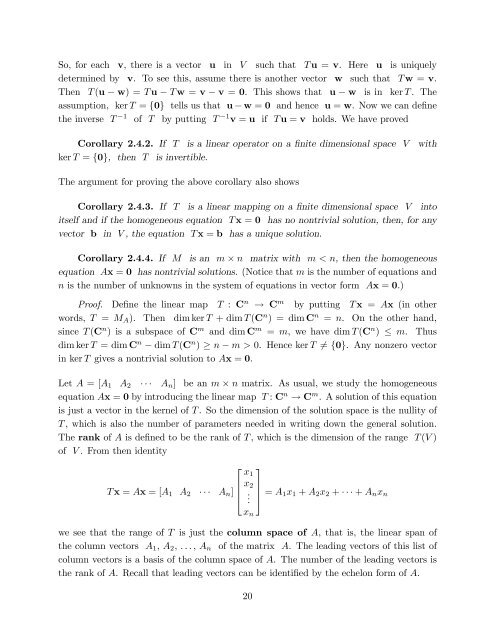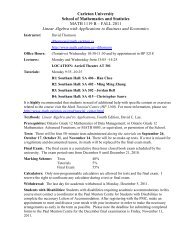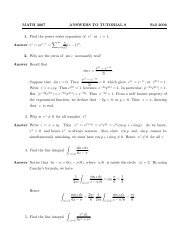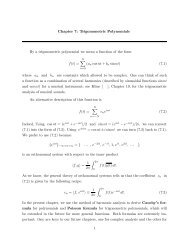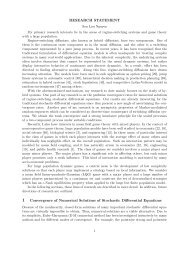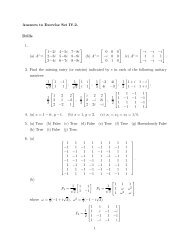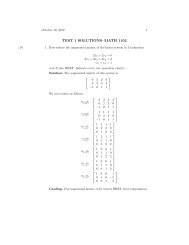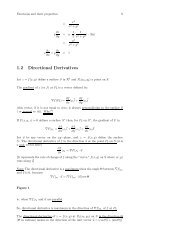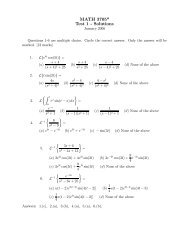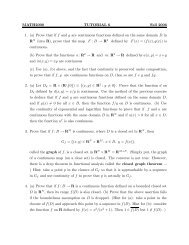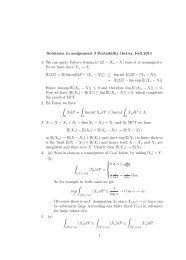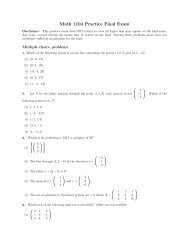CHAPTER II DIMENSION In the present chapter we investigate ...
CHAPTER II DIMENSION In the present chapter we investigate ...
CHAPTER II DIMENSION In the present chapter we investigate ...
Create successful ePaper yourself
Turn your PDF publications into a flip-book with our unique Google optimized e-Paper software.
So, for each v, <strong>the</strong>re is a vector u in V such that T u = v. Here u is uniquely<br />
determined by v. To see this, assume <strong>the</strong>re is ano<strong>the</strong>r vector w such that T w = v.<br />
Then T (u − w) = T u − T w = v − v = 0. This shows that u − w is in ker T . The<br />
assumption, ker T = {0} tells us that u − w = 0 and hence u = w. Now <strong>we</strong> can define<br />
<strong>the</strong> inverse T −1 of T by putting T −1 v = u if T u = v holds. We have proved<br />
Corollary 2.4.2. If T is a linear operator on a finite dimensional space V with<br />
ker T = {0}, <strong>the</strong>n T is invertible.<br />
The argument for proving <strong>the</strong> above corollary also shows<br />
Corollary 2.4.3. If T is a linear mapping on a finite dimensional space V into<br />
itself and if <strong>the</strong> homogeneous equation T x = 0 has no nontrivial solution, <strong>the</strong>n, for any<br />
vector b in V , <strong>the</strong> equation T x = b has a unique solution.<br />
Corollary 2.4.4. If M is an m × n matrix with m < n, <strong>the</strong>n <strong>the</strong> homogeneous<br />
equation Ax = 0 has nontrivial solutions. (Notice that m is <strong>the</strong> number of equations and<br />
n is <strong>the</strong> number of unknowns in <strong>the</strong> system of equations in vector form Ax = 0.)<br />
Proof. Define <strong>the</strong> linear map T : C n → C m by putting T x = Ax (in o<strong>the</strong>r<br />
words, T = MA). Then dim ker T + dim T (C n ) = dim C n = n. On <strong>the</strong> o<strong>the</strong>r hand,<br />
since T (C n ) is a subspace of C m and dim C m = m, <strong>we</strong> have dim T (C n ) ≤ m. Thus<br />
dim ker T = dim C n − dim T (C n ) ≥ n − m > 0. Hence ker T = {0}. Any nonzero vector<br />
in ker T gives a nontrivial solution to Ax = 0.<br />
Let A = [A1 A2 · · · An] be an m × n matrix. As usual, <strong>we</strong> study <strong>the</strong> homogeneous<br />
equation Ax = 0 by introducing <strong>the</strong> linear map T : C n → C m . A solution of this equation<br />
is just a vector in <strong>the</strong> kernel of T . So <strong>the</strong> dimension of <strong>the</strong> solution space is <strong>the</strong> nullity of<br />
T , which is also <strong>the</strong> number of parameters needed in writing down <strong>the</strong> general solution.<br />
The rank of A is defined to be <strong>the</strong> rank of T , which is <strong>the</strong> dimension of <strong>the</strong> range T (V )<br />
of V . From <strong>the</strong>n identity<br />
⎢<br />
T x = Ax = [A1 A2 · · · An] ⎢<br />
⎣<br />
⎡<br />
x1<br />
x2<br />
.<br />
xn<br />
⎤<br />
⎥<br />
⎦ = A1x1 + A2x2 + · · · + Anxn<br />
<strong>we</strong> see that <strong>the</strong> range of T is just <strong>the</strong> column space of A, that is, <strong>the</strong> linear span of<br />
<strong>the</strong> column vectors A1, A2, . . . , An of <strong>the</strong> matrix A. The leading vectors of this list of<br />
column vectors is a basis of <strong>the</strong> column space of A. The number of <strong>the</strong> leading vectors is<br />
<strong>the</strong> rank of A. Recall that leading vectors can be identified by <strong>the</strong> echelon form of A.<br />
20


